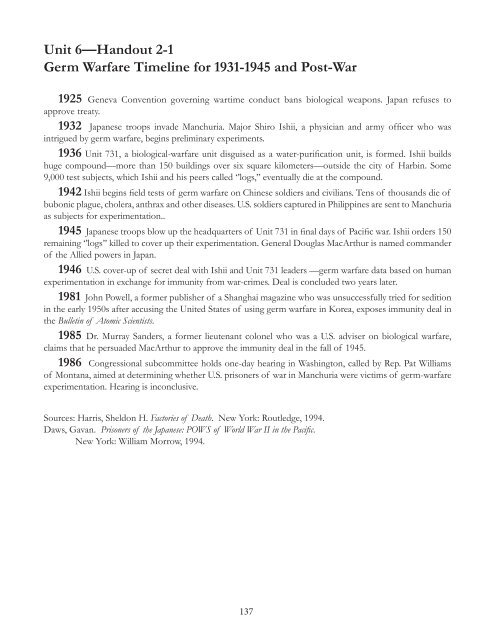Download - Canada ALPHA
Download - Canada ALPHA
Download - Canada ALPHA
Create successful ePaper yourself
Turn your PDF publications into a flip-book with our unique Google optimized e-Paper software.
Unit 6—Handout 2-1<br />
Germ Warfare Timeline for 1931-1945 and Post-War<br />
1925 Geneva Convention governing wartime conduct bans biological weapons. Japan refuses to<br />
approve treaty.<br />
1932 Japanese troops invade Manchuria. Major Shiro Ishii, a physician and army offi cer who was<br />
intrigued by germ warfare, begins preliminary experiments.<br />
1936 Unit 731, a biological-warfare unit disguised as a water-purifi cation unit, is formed. Ishii builds<br />
huge compound—more than 150 buildings over six square kilometers—outside the city of Harbin. Some<br />
9,000 test subjects, which Ishii and his peers called ‘’logs,’’ eventually die at the compound.<br />
1942 Ishii begins fi eld tests of germ warfare on Chinese soldiers and civilians. Tens of thousands die of<br />
bubonic plague, cholera, anthrax and other diseases. U.S. soldiers captured in Philippines are sent to Manchuria<br />
as subjects for experimentation..<br />
1945 Japanese troops blow up the headquarters of Unit 731 in fi nal days of Pacifi c war. Ishii orders 150<br />
remaining ‘’logs’’ killed to cover up their experimentation. General Douglas MacArthur is named commander<br />
of the Allied powers in Japan.<br />
1946 U.S. cover-up of secret deal with Ishii and Unit 731 leaders —germ warfare data based on human<br />
experimentation in exchange for immunity from war-crimes. Deal is concluded two years later.<br />
1981 John Powell, a former publisher of a Shanghai magazine who was unsuccessfully tried for sedition<br />
in the early 1950s after accusing the United States of using germ warfare in Korea, exposes immunity deal in<br />
the Bulletin of Atomic Scientists.<br />
1985 Dr. Murray Sanders, a former lieutenant colonel who was a U.S. adviser on biological warfare,<br />
claims that he persuaded MacArthur to approve the immunity deal in the fall of 1945.<br />
1986 Congressional subcommittee holds one-day hearing in Washington, called by Rep. Pat Williams<br />
of Montana, aimed at determining whether U.S. prisoners of war in Manchuria were victims of germ-warfare<br />
experimentation. Hearing is inconclusive.<br />
Sources: Harris, Sheldon H. Factories of Death. New York: Routledge, 1994.<br />
Daws, Gavan. Prisoners of the Japanese: POWS of World War II in the Pacifi c.<br />
New York: William Morrow, 1994.<br />
137


